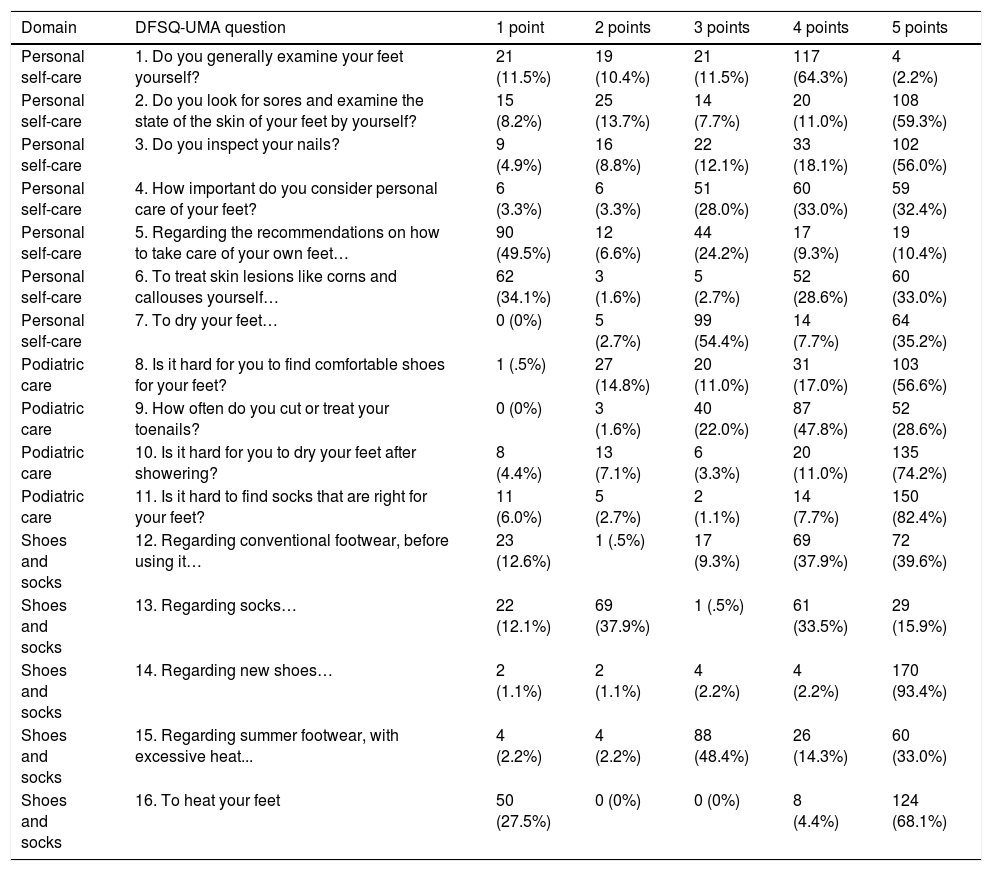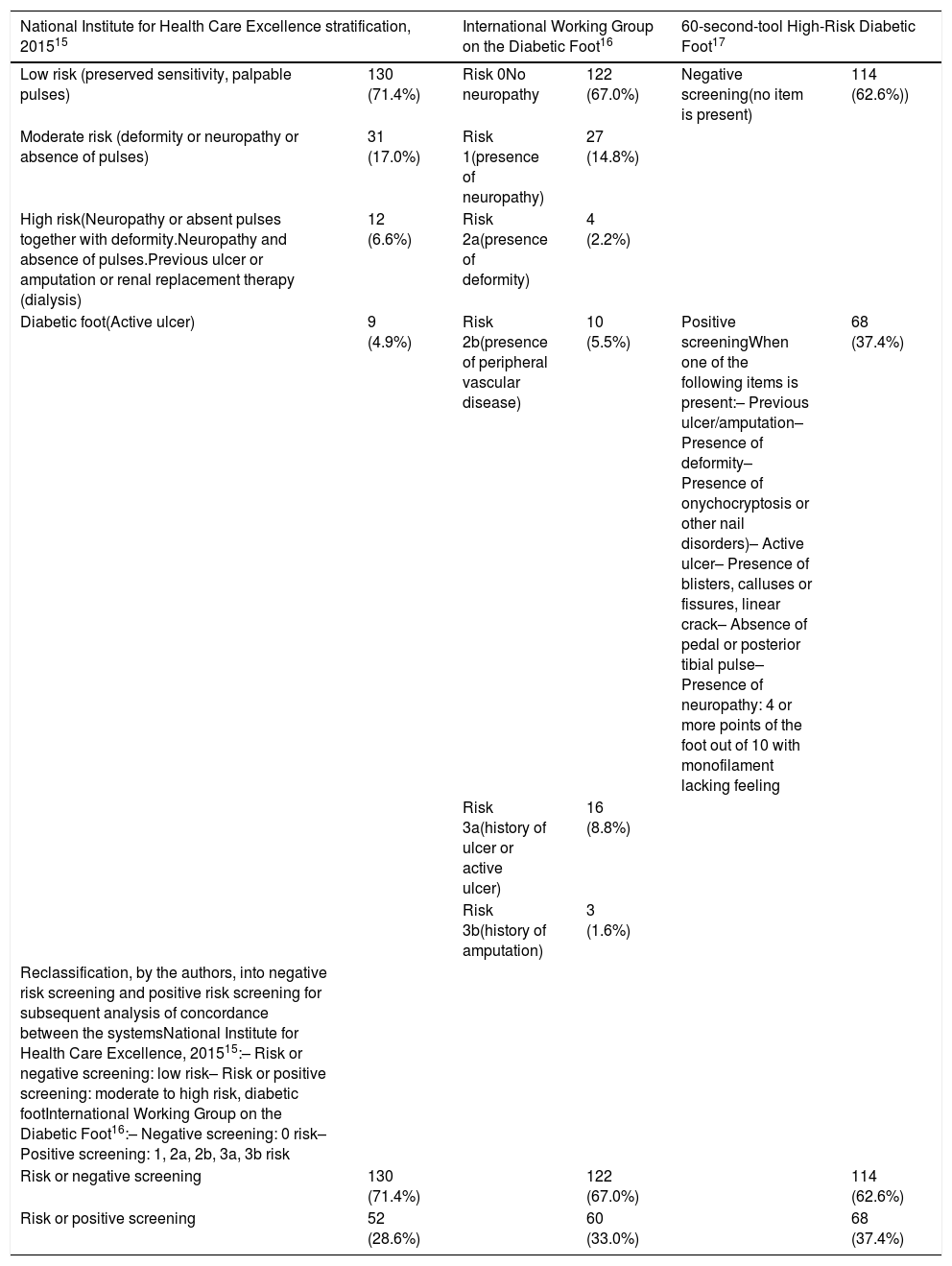To assess the level of self-care in the population with diabetes and determine the risk of diabetic foot lesions through the use of 3 stratification systems as well as to establish the degree of concordance between these systems.
MethodsObservational, cross-sectional and descriptive study carried out in the Basic Health Area of Santa Brígida (Gran Canaria-Canary Islands-Spain) in people diagnosed with diabetes (DM Type 1/DM Type 2) (n = 182). Interview, physical examination, review of clinical history and completion of the Diabetic Foot Self-Care questionnaire of the University of Malaga were carried out. The risk stratification was then calculated using 3 systems (System of the National Institute for Health Care Excellence, Classification of the International Working Group on the Diabetic Foot and High-Risk Diabetic Foot-60-Second Tool©-2012). The Kappa index was calculated to study the concordance between systems, the relative risk of negative screening of one method against another was estimated and the exact Fisher test to establish whether there were differences.
Results30.2% of diabetics had a low level of self-care, 45.1% a medium level and 24.7% a high level. The risk levels calculated were: National Institute for Health Care Excellence Classification (Negative Risk 71.4%-Positive Risk 28.6%), International Working Group on the Diabetic Foot Classification (Negative Risk 67.0%-Positive Risk 33.0%) and High-Risk Diabetic Foot-60-Second Tool©(Negative Risk 62.6%-Positive Risk 37.4%).
ConclusionsAll 3 systems have good concordance with each other. The High-Risk Diabetic Foot-60-Second Tool© only distinguishes 2 levels of risk but detects a higher percentage of people at risk. The Diabetic Foot Self-Care questionnaire of the University of Malaga may be useful in the context of Primary Care to assess the level of self-care of people with diabetes.
Evaluar el nivel de autocuidados en la población con diabetes y determinar el riesgo de padecer lesiones de pie diabético mediante el uso de 3 sistemas de estratificación, así como establecer el grado de concordancia entre estos sistemas.
MétodoEstudio observacional, transversal y descriptivo realizado en la Zona básica de salud de Santa Brígida (Gran Canaria, Islas Canarias, España) en personas diagnosticadas de diabetes (DM tipo 1/DM tipo 2) (n = 182). Se realizaron entrevista, exploración física, revisión de la historia clínica y cumplimentación del cuestionario Diabetic Foot Self-Care questionnaire of the University of Malaga. Tras ello se calculó la estratificación del riesgo con 3 sistemas (sistema del National Institute for Health Care Excellence, clasificación del International Working Group on the Diabetic Foot y High-Risk Diabetic Foot-60-Second Tool©2012). Se calculó el índicekappa para estudiar la concordancia entre sistemas, se estimaron el riesgo relativo de screening negativo de un método frente a otro y el test exacto de Fisher para establecer si existían diferencias.
ResultadosUn 30.2% de los diabéticos tenían un nivel bajo de autocuidados, un 45.1% un nivel medio y un 24.7% nivel alto. Los niveles de riesgo calculados fueron: fueron clasificación National Institute for Health Care Excellence (riesgo negativo 71.4%; riesgo positivo 28.6%), clasificación del International Working Group on the Diabetic Foot (riesgo negativo 67.0%; riesgo positive 33.0%) y High-Risk Diabetic Foot-60-Second Tool©(riesgo negativo 62.6%; riesgo positivo 37.4%).
ConclusionesLos 3 sistemas poseen una buena concordancia entre sí. El High-Risk Diabetic Foot-60-Second Tool© solo distingue 2 niveles de riesgo pero detecta mayor porcentaje de personas en situación de riesgo. El cuestionario Diabetic Foot Self-Care questionnaire of the University of Malaga puede ser útil en el contexto de Atención Primaria para evaluar el nivel de autocuidados de las personas con diabetes.
Artículo
Comprando el artículo el PDF del mismo podrá ser descargado
Precio 19,34 €
Comprar ahora











